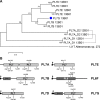Exploiting fine-scale genetic and physiological variation of closely related microbes to reveal unknown enzyme functions
- PMID: 28592491
- PMCID: PMC5546043
- DOI: 10.1074/jbc.M117.787192
Exploiting fine-scale genetic and physiological variation of closely related microbes to reveal unknown enzyme functions
Abstract
Polysaccharide degradation by marine microbes represents one of the largest and most rapid heterotrophic transformations of organic matter in the environment. Microbes employ systems of complementary carbohydrate-specific enzymes to deconstruct algal or plant polysaccharides (glycans) into monosaccharides. Because of the high diversity of glycan substrates, the functions of these enzymes are often difficult to establish. One solution to this problem may lie within naturally occurring microdiversity; varying numbers of enzymes, due to gene loss, duplication, or transfer, among closely related environmental microbes create metabolic differences akin to those generated by knock-out strains engineered in the laboratory used to establish the functions of unknown genes. Inspired by this natural fine-scale microbial diversity, we show here that it can be used to develop hypotheses guiding biochemical experiments for establishing the role of these enzymes in nature. In this work, we investigated alginate degradation among closely related strains of the marine bacterium Vibrio splendidus One strain, V. splendidus 13B01, exhibited high extracellular alginate lyase activity compared with other V. splendidus strains. To identify the enzymes responsible for this high extracellular activity, we compared V. splendidus 13B01 with the previously characterized V. splendidus 12B01, which has low extracellular activity and lacks two alginate lyase genes present in V. splendidus 13B01. Using a combination of genomics, proteomics, biochemical, and functional screening, we identified a polysaccharide lyase family 7 enzyme that is unique to V. splendidus 13B01, secreted, and responsible for the rapid digestion of extracellular alginate. These results demonstrate the value of querying the enzymatic repertoires of closely related microbes to rapidly pinpoint key proteins with beneficial functions.
Keywords: Vibrio splendidus; algae; alginate lyase; bacteria; enzyme kinetics; mass spectrometry (MS); nuclear magnetic resonance (NMR).
© 2017 by The American Society for Biochemistry and Molecular Biology, Inc.
Conflict of interest statement
The authors declare that they have no conflicts of interest with the contents of this article
Figures







References
-
- Falkowski P. G., Barber R. T., and Smetacek V. V. (1998) Biogeochemical controls and feedbacks on ocean primary production. Science 281, 200–207 - PubMed
-
- Alderkamp A. C., van Rijssel M., and Bolhuis H. (2007) Characterization of marine bacteria and the activity of their enzyme systems involved in degradation of the algal storage glucan laminarin. FEMS Microbiol. Ecol. 59, 108–117 - PubMed
-
- Myklestad S. M. (1995) Release of extracellylar products by phtyoplankton with special emphasis on polysaccharides. Sci. Total Environ. 165, 155–164
-
- Martin J. H., Knauer G. A., Karl D. M., and Broenkow W. W. (1987) VERTEX: carbon cycling in the northeast Pacific. Deep Sea Res. A 34, 267–285
Publication types
MeSH terms
Substances
Associated data
- Actions
- Actions
LinkOut - more resources
Full Text Sources
Other Literature Sources

